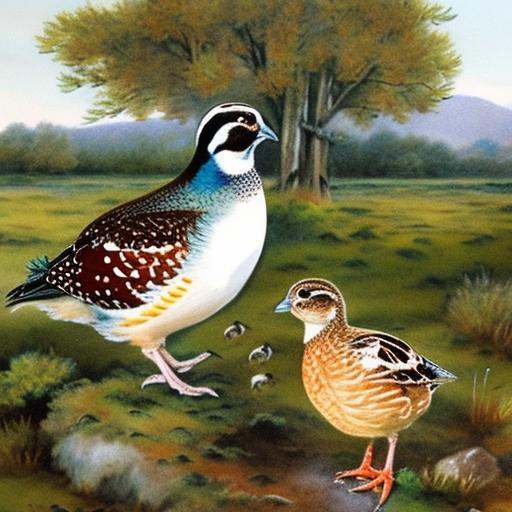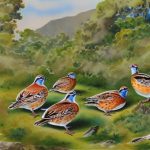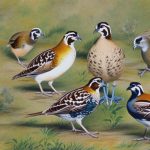Quail are small, ground-dwelling birds that belong to the family Phasianidae. There are several different breeds of quail, each with its own unique characteristics and traits. Some of the most popular quail breeds include the Coturnix quail, Bobwhite quail, Gambel’s quail, and California quail. Each breed has its own distinct physical appearance, behavior, and habitat preferences.
Coturnix quail, also known as Japanese quail, are one of the most commonly raised quail breeds for meat and egg production. They are known for their fast growth rate and high egg production, making them a popular choice for commercial quail farming. Bobwhite quail, on the other hand, are native to North America and are popular game birds. They are known for their distinctive call and are often hunted for sport. Gambel’s quail are found in the southwestern United States and are known for their striking plumage and distinctive topknot. California quail, also known as Valley quail, are found along the western coast of North America and are known for their sociable nature and distinctive “Chi-ca-go” call.
Each breed of quail has its own unique characteristics and traits that make them well-suited for different purposes, whether it be for meat and egg production, hunting, or ornamental purposes. Understanding the differences between these breeds is essential for anyone looking to raise quail.
Key Takeaways
- There are several different breeds of quail, each with unique characteristics and traits.
- Understanding the specific characteristics and traits of each quail breed is important for choosing the right one for your needs.
- When choosing a quail breed, consider factors such as egg production, temperament, and size.
- Breeding and raising different quail breeds requires knowledge of their specific needs and behaviors.
- Health and care considerations for various quail breeds include diet, housing, and common health issues.
The Characteristics and Traits of Each Quail Breed
Coturnix quail, also known as Japanese quail, are small birds with a plump body and a short, rounded tail. They come in a variety of colors including brown, white, and speckled. Coturnix quail are known for their fast growth rate and high egg production, making them a popular choice for commercial quail farming. They are also relatively docile and easy to handle, making them a good choice for beginners.
Bobwhite quail are native to North America and are popular game birds. They have a distinctive call that sounds like “bob-white” and are known for their quick, low flight when flushed. Bobwhite quail are small birds with mottled brown and white plumage, making them well-camouflaged in their natural habitat. They are also known for their strong parental instincts and will fiercely defend their nests and young.
Gambel’s quail are found in the southwestern United States and are known for their striking plumage and distinctive topknot. They have a bold black-and-white face pattern and a chestnut-colored belly. Gambel’s quail are social birds that live in coveys and are often seen running across the desert floor in search of food. They are also known for their distinctive “ka-KAA-ka” call.
California quail, also known as Valley quail, are found along the western coast of North America. They have a plump body, a forward-drooping crest, and a scaly appearance to their plumage. California quail are sociable birds that live in coveys and are often seen scratching for food on the ground. They have a distinctive “Chi-ca-go” call that is often used to communicate with other members of their covey.
Each breed of quail has its own unique characteristics and traits that make them well-suited for different purposes. Whether it be for meat and egg production, hunting, or ornamental purposes, understanding the specific traits of each breed is essential for anyone looking to raise quail.
Choosing the Right Quail Breed for Your Needs
When it comes to choosing the right quail breed for your needs, there are several factors to consider. First and foremost, you should consider the purpose for which you want to raise quail. If you are looking to raise quail for meat and egg production, then Coturnix quail may be the best choice due to their fast growth rate and high egg production. On the other hand, if you are interested in raising quail for hunting purposes, then Bobwhite quail may be the best choice due to their popularity as game birds.
Another factor to consider when choosing a quail breed is your available space and resources. Some breeds of quail may require more space or specific habitat requirements than others. For example, California quail are known for their sociable nature and may do best in larger aviaries or outdoor enclosures where they can live in coveys. Gambel’s quail, on the other hand, may prefer a desert-like habitat with plenty of open space to run and scratch for food.
It’s also important to consider your level of experience and expertise when choosing a quail breed. Some breeds of quail may be more challenging to raise than others, so it’s important to choose a breed that aligns with your knowledge and abilities. Ultimately, the right quail breed for you will depend on your specific needs, resources, and level of experience.
Breeding and Raising Different Quail Breeds
Breeding and raising different quail breeds requires careful planning and attention to detail. When it comes to breeding quail, it’s important to ensure that you have a suitable breeding pair or group that is healthy and genetically diverse. This will help to ensure the health and vitality of the offspring. It’s also important to provide a suitable nesting area with plenty of nesting material such as straw or hay.
Once the eggs have been laid, it’s important to carefully monitor the incubation process to ensure that the eggs develop properly. This may involve using an incubator with controlled temperature and humidity levels. Once the eggs hatch, it’s important to provide proper care and nutrition for the young chicks to ensure that they grow into healthy adults.
When it comes to raising different quail breeds, it’s important to provide a suitable habitat that meets their specific needs. This may involve providing appropriate shelter, food, water, and enrichment activities. It’s also important to monitor the health of the birds regularly and provide any necessary veterinary care.
Breeding and raising different quail breeds can be a rewarding experience, but it requires careful planning and attention to detail. By understanding the specific breeding and raising requirements of each breed, you can ensure the health and well-being of your quail flock.
Health and Care Considerations for Various Quail Breeds
When it comes to the health and care considerations for various quail breeds, there are several important factors to keep in mind. First and foremost, it’s important to provide a suitable habitat that meets the specific needs of each breed of quail. This may involve providing appropriate shelter, food, water, and enrichment activities.
It’s also important to monitor the health of your quail regularly and provide any necessary veterinary care. This may involve regular health checks, vaccinations, and parasite control measures. It’s also important to provide a clean environment with good ventilation to help prevent the spread of disease.
Another important consideration when it comes to the health and care of various quail breeds is nutrition. It’s important to provide a balanced diet that meets the specific nutritional needs of each breed. This may involve providing a commercial feed formulated specifically for quail as well as supplemental foods such as fruits, vegetables, and insects.
By paying careful attention to the health and care considerations for various quail breeds, you can help ensure the health and well-being of your flock. This may involve providing a suitable habitat, monitoring their health regularly, providing proper nutrition, and seeking veterinary care when necessary.
The Economic Viability of Different Quail Breeds

When it comes to the economic viability of different quail breeds, there are several factors to consider. First and foremost, it’s important to consider the purpose for which you want to raise quail. If you are looking to raise quail for meat and egg production, then certain breeds such as Coturnix quail may be more economically viable due to their fast growth rate and high egg production.
Another factor to consider when evaluating the economic viability of different quail breeds is market demand. Some breeds of quail may be more popular or in higher demand than others, which can impact their economic viability. For example, Bobwhite quail are popular game birds and may have a higher market value compared to other breeds.
It’s also important to consider the cost of raising different quail breeds including housing, feed, veterinary care, and other expenses. Some breeds of quail may be more cost-effective to raise than others due to factors such as feed conversion rates or disease resistance.
Ultimately, the economic viability of different quail breeds will depend on a variety of factors including market demand, production costs, and your specific goals as a quail farmer or hobbyist.
Resources for Further Learning about Breeds of Quail
For those interested in further learning about breeds of quail, there are several resources available that can provide valuable information and guidance. One valuable resource is books on raising quail which can provide in-depth information on different breeds including their characteristics, traits, breeding requirements, health considerations, and more.
Another valuable resource is online forums and communities dedicated to raising quail where you can connect with other quail enthusiasts who can share their experiences and knowledge about different breeds of quail.
Additionally, there are educational workshops and seminars on raising quail that can provide hands-on learning opportunities about different breeds as well as practical tips for breeding, raising, and caring for various types of quail.
Finally, reaching out to local breeders or farmers who have experience raising different breeds of quail can provide valuable insights into the specific requirements and considerations for each breed.
By utilizing these resources for further learning about breeds of quail, you can gain valuable knowledge that will help you make informed decisions about which breed is right for you based on your specific goals and needs as a quail farmer or enthusiast.
If you’re interested in learning more about breeds of quail, you might also find our article on what vegetables do quails eat to be helpful. Understanding the dietary needs of quails is essential for their health and well-being.
FAQs
What are the different breeds of quail?
There are several different breeds of quail, including the Coturnix quail (also known as Japanese quail), Bobwhite quail, Gambel’s quail, California quail, and Mountain quail.
What are the characteristics of Coturnix quail?
Coturnix quail are known for their small size, rapid growth, and high egg production. They come in a variety of colors, including brown, white, and tuxedo.
What are the characteristics of Bobwhite quail?
Bobwhite quail are native to North America and are known for their distinctive call. They are popular game birds and are often raised for hunting purposes.
What are the characteristics of Gambel’s quail?
Gambel’s quail are found in the southwestern United States and are known for their striking plumage and distinctive topknot. They are often found in desert habitats.
What are the characteristics of California quail?
California quail are known for their bold and striking plumage, with a distinctive teardrop-shaped crest on their heads. They are found along the western coast of North America.
What are the characteristics of Mountain quail?
Mountain quail are found in the western United States and are known for their shy and elusive nature. They have a unique call and are often found in mountainous habitats.
Meet Walter, the feathered-friend fanatic of Florida! Nestled in the sunshine state, Walter struts through life with his feathered companions, clucking his way to happiness. With a coop that’s fancier than a five-star hotel, he’s the Don Juan of the chicken world. When he’s not teaching his hens to do the cha-cha, you’ll find him in a heated debate with his prized rooster, Sir Clucks-a-Lot. Walter’s poultry passion is no yolk; he’s the sunny-side-up guy you never knew you needed in your flock of friends!







